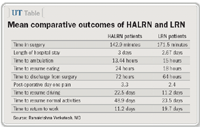Article
Hand assist vs. 'pure' laparoscopy outcomes similar
St. Louis--Little difference appears to exist between pure laparoscopy and hand-assisted laparoscopic radical nephrectomy in terms of immediate postoperative outcomes, according to what may be the first prospective, randomized trial comparing the two techniques.

"According to our study, there is not much difference between hand-assisted laparoscopic nephrectomy [HALRN] and standard laparoscopic radical nephrectomy [LRN] in terms of intra- and postoperative complications," Ramakrishna Venkatesh, MD, assistant professor of surgery at the Washington University School of Medicine in St. Louis, told Urology Times.
"The hospital stay is slightly longer in the hand-assisted group. However, though this is a prospective randomized study, there is more than a decade of age difference between the two groups. Further accrual of patients for the study may show that there is actually no difference between the two groups," he said in a presentation at the AUA annual meeting.

Intraoperative data were nearly similar. The mean tumor size for LRN was 5.7 cm compared with 5.4 cm for HALRN. The hand-assisted procedure was a little faster, averaging 142.9 minutes compared with 171.5 minutes for standard laparoscopy. The average hospital stay was 3 days for HALRN and 2.67 days for LRN. The hand-assisted laparoscopy patients were able to ambulate in half a day (13.44 hours), and they were able to eat in 1 day. They were discharged 3 days postoperatively.
Standard laparoscopy patients were able to ambulate in 15 hours and able to eat at 18 hours. They were discharged, on average, at 2 days, 16 hours. On a scale of 1 to 10, the HALRN patients reported postoperative pain on day one to be 3.3 compared with the LRN patients, who reported their day one pain at 2.4.
Long-term data showed substantial divergence. HALRN patients reported their time to return to driving to be 22.5 days, time to return to normal activity to be 48.9 days, and time to return to work to be 52 days. LRN patients reported returning to driving as 11.2 days, returning to normal activity as 23.5 days, and returning to work as 19.7 days.
Dr. Venkatesh said he believes much of the difference in long-term recovery between the two cohorts lies in the age difference.
"This may have nothing to do with either procedure. These long-term recovery data could be entirely related to age. At 68, these [HALRN] patients are not in a rush to get back to work. Most of them are probably retired," said Dr. Venkatesh.
As all patients were randomized to one procedure or another by the flip of a coin, the culprit behind the age discrepancy may be a faulty quarter or a temporary suspension of the law of averages. The doctor expects the age discrepancy to narrow or disappear as the trial continues to accrue patients. At this point, the efficacy and immediate outcomes make it difficult to choose one technique over the other.
"There are seldom complications [with either technique], and most patients go home within a similar time period," he said.
"The hand-assisted patients appear to recover their bowel function as quickly as the standard laparoscopy patients. The pain scores between the two groups are more or less similar."
The definitive outcome awaits more patients and a newer quarter.
















